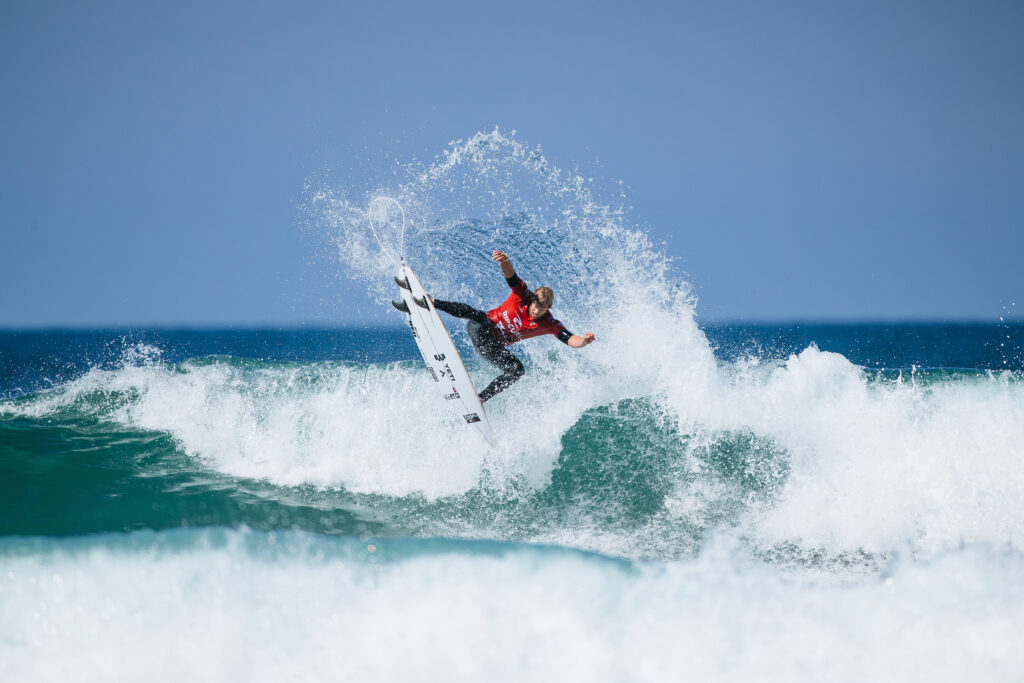Barron Mamiya Won Pipe On A Pair Of Borrowed Fiberglass Prototype Fins
Illuminating the full circle moment occurring under the back feet of the world’s best.
In partnership with FCS
Orville Wright once suggested that ‘no flying machine will ever fly from New York to Paris’.
In the 1990s, countless similar predictions were made about the likelihood of removable fin systems usurping glass-on fins.
“There were quite a few resistors, glass-on purists back in the day,” says Richie Lovett, former World Tour surfer and longtime FCS test-pilot. “Andy Irons and Taj Burrow especially, along with some others. But, ultimately, they all converted. The main difference really, between the fixed fins that you put on boards and any fin system that you put into a board, are the rovings that connect a glass-on fin. Once we eliminated them, I think everyone felt the boards were going faster. Eliminating those rovings means the water going across the fin doesn’t change direction. Rovings force the water to go up, and change direction, slowing you down. The one downside is that there was this connection between the fin and the surfboard that was potentially lacking. That’s the feel that purists and fixed fin advocates always note. There’s a definite connection between the fin and the board when it’s set in the board. So, at FCS, we’ve spent so much time trying to emulate that feel by making fins in different materials.”

If you’re attentive to the rudders which guide the vessels of the best surfers in the world, you’ll have noticed a quiet trend in the form of opaque, often greyish, fiberglass skeggs.
John Florence, Ethan Ewing, Jack Robinson, Matty McGillivray, Carissa Moore, Barron Mamiya, Caroline Marks, and a handful of others have begun returning to fiberglass templates — often in the form of prototypes, and often in more powerful surf.
Why?
“It’s been a bit of a full circle moment actually,” says Richie. “When the systems first came out, most of the fins were made from a composite material like plastic. Those fins definitely over-flexed. They didn’t have a lot of memory recall, meaning when the fins flexed out, there was a delay in the way the fins came back.”
From there — in the early 2000s — FCS went towards the original Performance Core construction, then known as Resin Transfer Molded fins. They started putting layers of fiberglass, followed by a ‘core’ material, more layers of fiberglass, and then injected resin. The aim was to have more controllable variables in relation to the flex pattern.

“After that, we evolved into making fins from solid panel fiberglass,” says Richie. “Layers and layers of fiberglass made with resin from a huge sheet. Surfers gelled with that flex, because it felt super close to having glass ons, but with added speed. That actually became the norm towards the mid 2000s. After that period, we went back into the whole Performance Core technology, but started to integrate different foam cores, different hex cores. We started to use a combination of carbon framework in there as well as layers of fiberglass, foam cores, and different resins.”
The latter constructions make up the majority of the fins on the market — and likely in your quiver — today.
“We got to the point where we were basically customizing the flex and the template to exactly what surfers like Mick and Kelly wanted. But, like I said, that full circle moment feels like it’s happened in the last 12 to 18 months.
“We use a prototyping process where we make everything out of Performance Glass first, but lately our athletes have been coming back and saying that the prototype fins just feel amazing. So we’ve leaned into that with our most popular templates — the Merricks, Micks, and Filipes — and they’re actually going really well.”
Case in point, Barron Mamiya snagged some prototype glass fins which FCS had originally sent to Britt Merrick, and won the 2024 Lexus Pipe Pro on them.
“They felt super good, lots of drive, tons of hold,” said Barron, above. “I was just super stoked on them. I think by far this new glass is the best fins I’ve ever ridden. I felt like I could float over foamballs a lot better, the back of my board just felt sturdy.”
“I feel a big difference,” he continues. “Off the bottom they’re insane. You’ll have fins where you can tell that you’re getting drive off the bottom but the speed doesn’t carry through the rest of the wave, but these fins do it all.”
Hard to argue against a man with a Yeti 110 cooler next to his Pipeline Trophy.
“Because Performance Glass fins feel a touch heavier, when it’s bumpier and windier it sort of settles your board a little bit too, it tends to settle any flightiness or jittery feeling that you might have in the tail,” suggests Richie. “They kind of anchor the tail of the board into waves where you may be looking for control.
“Ultimately, it’s just another material that’s being offered. We’re positioning Performance Glass as a fin for power surfers, people who are traveling, surfing Indo type waves, who want a really reliable fin that they can depend on when critical. And it’s just that feeling of the board and fin being connected as one.”
And yet, though much of the chatter seems to suggest fiberglass fins are meant for powerful, heavy sections, more than a handful of CTers have been riding them in everything, including Ethan Ewing and Matty McGillivray
“I got the fiberglass fins in Hawaii this year in the Mick Fanning template,” Matty told me. “They’re noticeably stiffer and offer more drive. I use a more upright fin in Hawaii because it’s more about controlling speed than trying to generate it. But then, when I got to Australia I started using the large fiberglass Mick fins at Bells, and it actually suited the softer waves at Winkipop. I could get around sections easier and push harder in my turns. I only have one set of the Micks, so I need to get my hands on a few different models and sizes because I want to experiment more with this feeling. The fiberglass fin honestly provides better overall performance for me than the standard ones”

Britt Merrick sums it up tidily — on the heels of creating a glass fin for Dane Reynold’s recent Dumpster Diver 2.
“Fiberglass feels the most like surfing,” he says. “Fiberglass is in our DNA as surfers, it’s what we’ve known since 1955. Everything we’ve made has been constructed of fiberglass. I think it feels the most natural, the most connected, and the flex pattern makes the most sense. Younger surfers are finally feeling something they haven’t felt in a while. It feels like it ties everything together.”
— — —
We’ll have a full Premium story on the industry wide adoption of fiberglass fins coming soon.




